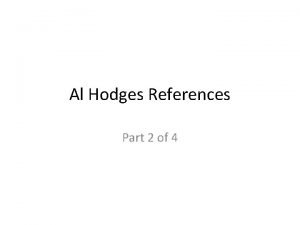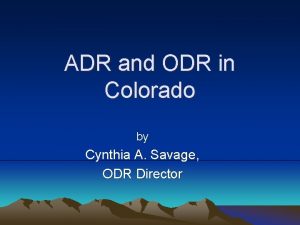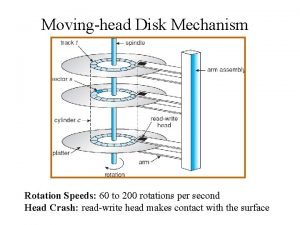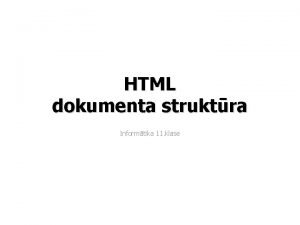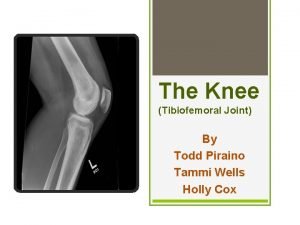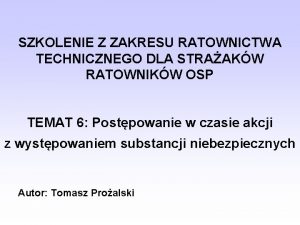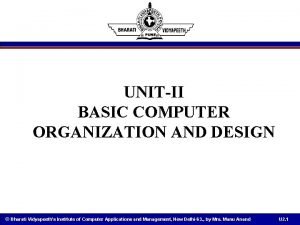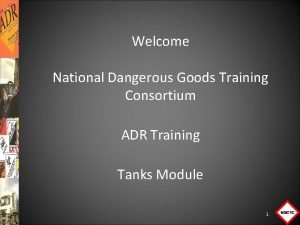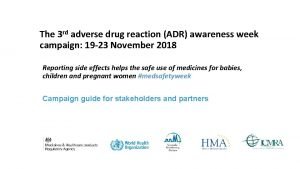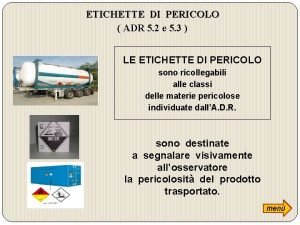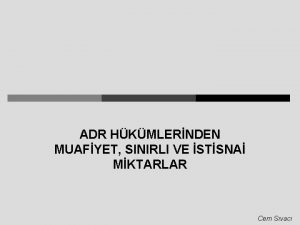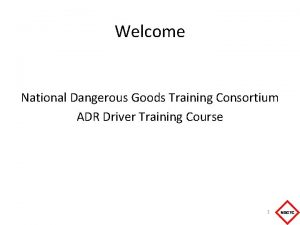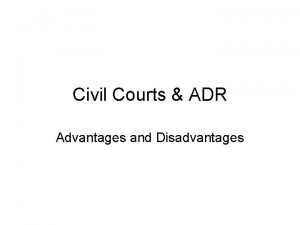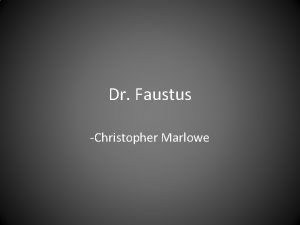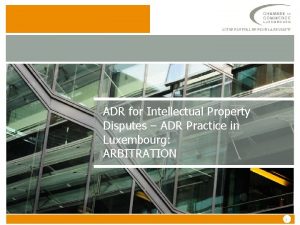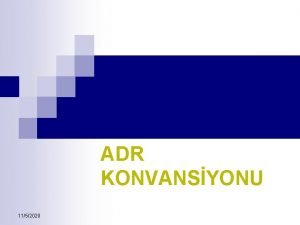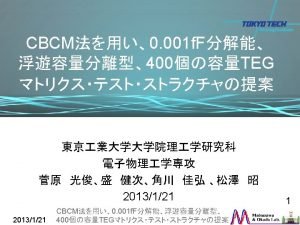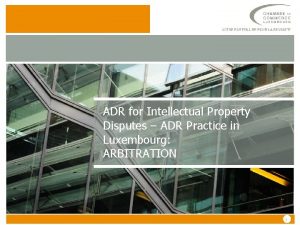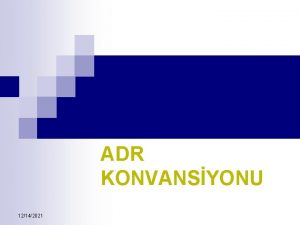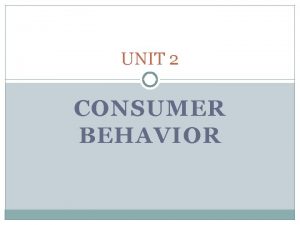ADR Consumer ADR ODR Christopher Hodges Head of






































- Slides: 38

ADR, Consumer ADR, ODR Christopher Hodges Head of the CMS/Swiss Re Research Programme on Civil Justice Systems, Centre for Socio. Legal Studies, University of Oxford Life member, Wolfson College, Oxford Erasmus Professor of the Fundamentals of Private Law, Erasmus University, Rotterdam Solicitor of the Superior Courts of England Wales

Comprehensive EU coverage for Consumer ADR § Directive 2013/11 on alternative dispute resolution for consumer disputes and amending Regulation (EC) No 2006/2004 and Directive 2009/22/EC (Directive on consumer ADR)’. § Regulation (EC) No 534/2013 on online dispute resolution for consumer disputes (Regulation on consumer ODR)


Classic ADR 1. The context is usually civil procedure 2. Typically mediation 1. 2. Before the procedure, eg English pre-action protocols During the procedure 3. Advantages: informal; parties own the process, the negotiation and the solution; confidential so can make admissions; flexible outcomes; can restore trust or relations 4. Disadvantages: transparent justice? Contribution to clarification of law? Independence of third party? C Menkel-Meadow, Dispute Resolution: Beyond the Adversarial Model (2005; 2 nd ed. 2011); C Menkel-Meadow, ‘Dispute Resolution’ in Cane & Kritzer, The Oxford Handbook of Empirical Legal Research (Oxford, 2010); and many others

ADR - EU Mechanisms § § § § § Council Resolution of 25 May 2000 on a Community-wide network of national bodies for the extra-judicial settlement of consumer disputes, [2000] O. J. C 155/1 Commission Recommendation 98/257/EC on the Principles Applicable to the Bodies Responsible for Out-of-Court Settlement of Consumer Disputes, [1998] OJ L 155/31 Commission Recommendation 2001/310/EC on the Principles for Out-of-Court Bodies involved in the Consensual Resolution of Consumer Disputes, [2001] OJ L 109, 56 -61 Financial Services Complaints Network, FIN-NET, 2001 European Code of Conduct for Mediators, 2004 Commission Directive 2008/52/EC of the European Parliament and of the Council of 21 May 2008 on certain aspects of mediation in civil and commercial matters, [2008] O. J. L 136/3 Consultation paper on the use of Alternative Dispute Resolution as a means to resolve disputes related to commercial transactions and practices in the European Union (European Commission, January 2011) Directive of the European Parliament and of the Council on alternative dispute resolution for consumer disputes and amending Regulation (EC) No 2006/2004 and Directive 2009/22/EC (Directive on consumer ADR), 2013/11/EU Regulation 524/2013 of the European Parliament and of the Council on online dispute resolution for consumer disputes (Regulation on consumer ODR), 2013

Measures that encourage Member States to establish ADR schemes § Distance Marketing of Financial Services Directive 2002/65/EC § Timeshare Directive 2008/122/EC § E-commerce Directive (EC) 2000/31 § Postal Services Directive EC) 2008/6 amending 97/67/EC § Insurance Mediation Directive 2002/92/EC § Markets in Financial Instruments Directive (Mi. FID) (EC) 2004/39 on markets in financial instruments amending 85/611/EEC, 93/6/EEC and 2000/12/EC and repealing 93/22/EEC

Measures that require Member States to establish ADR schemes § Directive (EC) 2009/136 amending Directive 2002/22/EC on universal service and users’ rights relating to electronic communications networks and services § Directive (EC) 2009/72 concerning common rules for the internal market in electricity and repealing Directive 2003/54/EC, [2009] OJ L 211/55; and Directive (EC) 2009/73 concerning common rules for the internal market in natural gas and repealing Directive 2003/55/EC § Directive (EC) 2008/48 on credit agreements for consumers § Directive (EC) 2007/64 on payment services in the internal market amending Directives 97/7/EC, 2002/65/EC, 2005/60/EC § Regulation (EU) No 181/2011 on bus and coach passenger rights [complaints function either in house or external; also complaints and enforcement authority]

The Vision for CDR 1. Improving access to Justice a) b) c) d) e) Claims values are low Consumers’ attitudes to cost proportionality Cost to consumers Duration User-friendliness and accessibility 2. Providing consumer advice, to underpin informed purchasing 3. Enabling the CDR system to deliver regulatory output and raise trading standards 4. Responding to consumer issues







France Telecoms: 3 Insurance: 3 - 6 Banks: 6 GDF/SUEZ: 2 Travel: 2 - 4 National Energy mediator: 6 Germany Telecoms: 4 Insurance: 4. 1 Banks: no data Travel: 3 Poland Telecoms: no data Consumer arbitration tribunals: 0. 5 - 2 Banking: 1. 1 Trade inspection consumer: no data Energy: no data Spain Telecoms: no data Insurance /pensions: 4 Banking: 4 -6 Investment: no data Energy: 2 UK Telecoms: 6 or less Pensions: 10. 9 Banks/Insurance: 2. 2 FLA: 2 Energy: xx Travel: 22. 5


Sweden Trader Information Dispute

Main economic sectors concerned by complaints Transport, of which: -Air transport (including problems with luggage) -Car rental Percentage 32. 1% 21. 6% 3. 4% Timeshare related products and package holidays 7. 4% Recreational, sporting and cultural services 7. 0% Furnishing, household equipment and routine household maintenance 6. 8% Audio-visual, photographic and information processing equipment 5. 6% Health 5. 1% Communication 4. 7% Clothing and footwear 4. 5% Hotels and restaurants 4. 5% Personal care goods and services 3. 0% Financial services and insurance 2. 5%

2007 2008 2009 2010 2011 2012 Contacts 50. 930 62. 569 60. 755 71. 292 70. 207 72. 067 Complaints 24. 810 26. 674 27. 601 28. 927 26. 909 32. 197 Information requests 22. 284 29. 243 25. 875 27. 060 28. 108 26. 399



The added value of CDR Ø More attractive and cheaper for users than courts Ø Regulation of market behaviour: Ø Ø Ø capture of complaint data aggregation identification of issues and trends publication enable regulatory action Collective redress by CDRs + Regulators Ø Swifter identification of a systemic issue Ø Application of a generic solution

Three Pillar Model of Enforcement Public Regulation ADR Private Litigation

Proposition 1. The central pathways for C 2 B dispute resolution in Europe will be new CADR/CDR/ODR 2. Regulatory oversight of compensation as part of enforcement of compliance 3. Courts (and lawyers) will have a residual and more restricted role

Commission CDR 2013 Legislation 1. Gaps in coverage • • Sectors Member States Fill gaps by mandatory horizontal cover Lessons from Netherlands/Nordic unified model ODR platform 2. Lack of awareness How increase usage? visibility and adherence: National, EU and global umbrellas 3. Variation in quality Quality principles (the 2 recommendations) and regulatory scheme with national competent authorities 4. ODR Platform


How to achieve the objectives? 1. The primary principle: Consumer ADR (‘CDR’) must be effective (art 8). 2. Quality principles must be respected. a) b) c) d) e) CDR entities must be expert, independent and impartial (art 6. 1). CDR entities that do not meet the standards must be improved or closed (arts 18 -20). National competent authorities (‘NCAs’) overseeing CDR entities must be effective. Data on the operation of CDR entities should be published (art 7). There should be agreement and clarity on which rules are being applied (art 7. 1. 1), i. e. law, fairness, equity, terms and conditions, etc.

Anticipating criticism 1. Unconstitutional 2. Blocks access to courts 3. Private justice bodies 4. Inconsistent decisions 5. Expense of regulating private bodies 6. Some business sectors don’t need CDR

Criteria for democratic acceptance of Dispute Resolution Procedures § The right to access to justice and to a fair trial: Art 6 ECHR § The right to an e�ective remedy and to a fair trial: Art 47 EUCFR § Commission Recommendation (EC) 98/257/EC on the principles applicable to the bodies responsible for the out-of-court settlement of consumer disputes, [1998] OJ L 115 § Commission Recommendation (EC) 2001/310 on the principles for out-of-court bodies involved in the consensual resolution of consumer ADR, OJ L 109 56

Modes: Historical Evolution of Models Courts: Procedural Justice Arbitration: panels of 3 Spain Nordic Consumer Complaint Boards Netherlands Geschillencommissie UK Self-regulatory systems (Codes) and hybrids Mediation: French médiateurs: in ministries/regulators and companies Public Ombudsmen (privatised, regulated industry sectors) and/or private sector Ombudsmen: single case handlers and ombudsmen

Techniques: an escalating pyramid Adjudication binding or non-binding Mediation/ Conciliation Refer to Third Party: Triage Direct contact Consumer - trader




Netherlands Model GCS


Three Tiers 1. Traders: encouraged to respond to customer feedback 2. CDR: a seamless service to users: a) Residual CDR function b) Sectoral specialist CDRs funded by business 3. Enforcers: linked in, with behavioural and redress powers

Conclusion § CDR is good for consumers, traders, markets, and economic prosperity § We need to make it work § Governments and ombudsmen and enforcers need to make the right design choices now
 Energy pyramid
Energy pyramid Amanda hodges uf
Amanda hodges uf Zane hodges
Zane hodges Al hodges
Al hodges Obergefell v hodges summary
Obergefell v hodges summary Adam joseph hodges
Adam joseph hodges Mandy: “can i help you?” mandy wanted to know
Mandy: “can i help you?” mandy wanted to know Odr colorado
Odr colorado Mokka odr
Mokka odr Consumer research process
Consumer research process Characteristics of consumer behavior
Characteristics of consumer behavior Herbivores in the sahara desert
Herbivores in the sahara desert Business buyer behavior refers to the
Business buyer behavior refers to the Consumer diversity in consumer behaviour
Consumer diversity in consumer behaviour The attacking firm goes head-to-head with its competitor.
The attacking firm goes head-to-head with its competitor. Dividing head uses
Dividing head uses Pre-head head tonic syllable tail
Pre-head head tonic syllable tail The head of moving head disk with 100 tracks
The head of moving head disk with 100 tracks Html tagi
Html tagi Flooded suction pump
Flooded suction pump Disk
Disk Condyles of femur
Condyles of femur Shins body
Shins body The tone unit
The tone unit Adr turvaohjekortti
Adr turvaohjekortti Adr tabela
Adr tabela Liczba czterocyfrowa w mianowniku tablicy adr
Liczba czterocyfrowa w mianowniku tablicy adr During _____ branching, only car is updated with adr
During _____ branching, only car is updated with adr National dangerous goods training consortium
National dangerous goods training consortium Adr classification
Adr classification Reaction turbine animation
Reaction turbine animation Etichette pericolo adr
Etichette pericolo adr Adr 2021 könyv
Adr 2021 könyv Sınırlı miktar etiketi
Sınırlı miktar etiketi Azalastyna
Azalastyna Tablice adr przykłady
Tablice adr przykłady Adr poäng
Adr poäng Adr consortium
Adr consortium Advantages and disadvantages of being a lawyer
Advantages and disadvantages of being a lawyer



